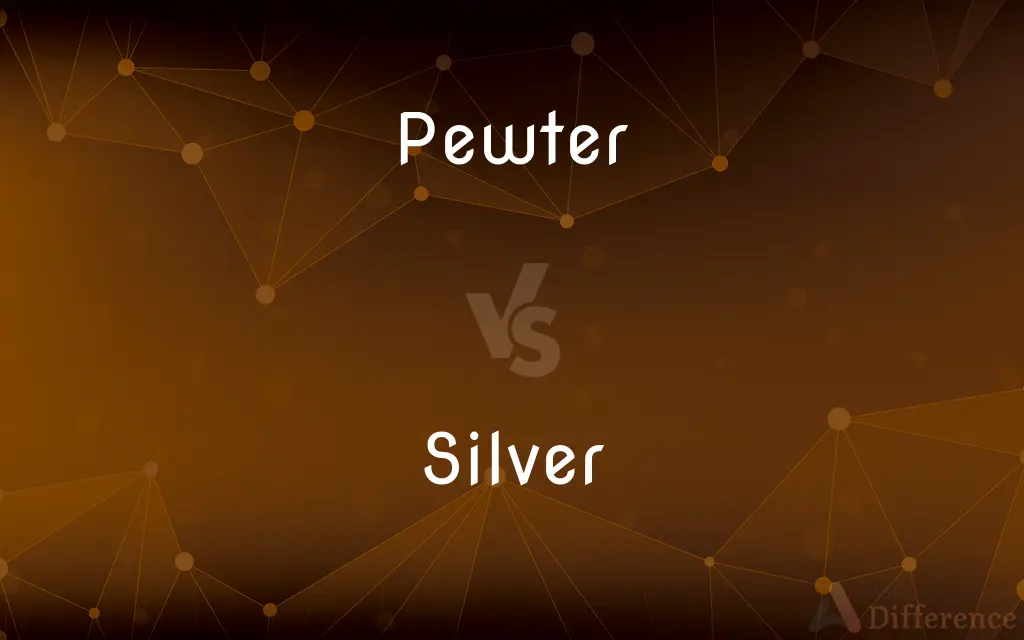Pewter vs. Silver — What's the Difference?
By Tayyaba Rehman — Updated on September 23, 2023
Pewter is a malleable metal alloy primarily of tin, while silver is a precious metal known for its shine and value.

Difference Between Pewter and Silver
Table of Contents
ADVERTISEMENT
Key Differences
Pewter and silver are both metals that have historically been used for making various objects, especially utensils and jewelry. Pewter, a metal alloy, typically comprises tin, with small amounts of other metals like copper or antimony. Silver, in contrast, is a pure elemental metal recognized for its distinct lustrous shine.
The properties of pewter and silver differ significantly. Pewter, known for its softness, is easily shaped and crafted into intricate designs. Silver, while also malleable, possesses a higher degree of durability and resistance to tarnishing when compared to pewter.
In terms of value, pewter and silver have different standings. Silver, being a precious metal, often holds significant monetary worth, especially in its pure form. Pewter, while valuable in historical and artisan contexts, doesn't command the same price as silver.
Throughout history, both pewter and silver have found applications in various domains. Pewter was a popular material for plates, cups, and other household items in medieval Europe. Silver, due to its purity and aesthetic appeal, has been a preferred choice for jewelry, coins, and luxury items.
When considering care and maintenance, pewter and silver items require different approaches. Pewter objects can be maintained with gentle cleaning to preserve their finish. Silver items, however, need regular polishing to prevent tarnishing and retain their luster.
ADVERTISEMENT
Comparison Chart
Composition
Metal alloy primarily of tin
Pure elemental metal
Durability
Softer and less durable
More durable and resistant to tarnish
Value
Generally less valuable than silver
Considered a precious metal with high value
Historical Usage
Used for household items like plates and cups
Used for jewelry, coins, luxury items
Care
Gentle cleaning to maintain finish
Regular polishing to prevent tarnish
Compare with Definitions
Pewter
Known for its soft and malleable nature.
Artisans often prefer pewter for crafting intricate designs.
Silver
A lustrous white precious metal.
The necklace was made of pure silver.
Pewter
Historically used for everyday household items.
Pewter plates were common in European households.
Silver
Symbolic of purity and luxury.
The silver chalice was reserved for special ceremonies.
Pewter
A metal alloy mainly consisting of tin.
The medieval goblet was made of pewter.
Silver
Silver is a chemical element with the symbol Ag (from the Latin argentum, derived from the Proto-Indo-European h₂erǵ: "shiny" or "white") and atomic number 47. A soft, white, lustrous transition metal, it exhibits the highest electrical conductivity, thermal conductivity, and reflectivity of any metal.
Pewter
Less resistant to tarnishing than silver.
Over time, the pewter jewelry developed a dull patina.
Silver
Symbol Ag A lustrous white, ductile, malleable metallic element, occurring both uncombined and in ores such as argentite, having the highest thermal and electrical conductivity of the metals. It is highly valued for jewelry, tableware, and other ornamental use and is widely used in coinage, photography, dental and soldering alloys, electrical contacts, and printed circuits. Atomic number 47; atomic weight 107.868; melting point 961.78°C; boiling point 2,162°C; specific gravity 10.50 (20°C); valence 1, 2. See Periodic Table.
Pewter
Requires gentle cleaning for maintenance.
The pewter mug was cleaned carefully to preserve its finish.
Silver
This metallic element as a commodity or medium of exchange.
Pewter
Pewter () is a malleable metal alloy consisting of tin (85–99%), antimony (approximately 5–10%), copper (2%), bismuth, and sometimes silver. Copper and antimony (and in antiquity lead) act as hardeners but lead may be used in lower grades of pewter, imparting a bluish tint.
Silver
Coins made of this metallic element.
Pewter
Any of numerous silver-gray alloys of tin with various amounts of antimony, copper, and sometimes lead, used widely for fine kitchen utensils and tableware.
Silver
A medal made of silver awarded to one placing second in a competition, as in the Olympics.
Pewter
Pewter articles considered as a group.
Silver
Domestic articles, such as tableware, made of or plated with silver.
Pewter
An alloy of approximately 93–98% tin, 1–2% copper, and the balance of antimony.
Silver
Tableware, especially eating and serving utensils, made of steel or another metal.
Pewter
(historical) An alloy of tin and lead.
Silver
A lustrous medium gray.
Pewter
Items made of pewter; pewterware.
Silver
A silver salt, especially silver nitrate, used to sensitize paper.
Pewter
A beer tankard made from pewter.
Silver
Made of or containing silver
A silver bowl.
Silver ore.
Pewter
A dark, dull grey colour, like that of the metal.
Silver
Resembling silver, especially in having a lustrous shine; silvery.
Pewter
Prize money.
Silver
Of a lustrous medium gray
Silver hair.
Pewter
Of a dark, dull grey colour, like that of the metal.
Silver
Having a soft, clear, resonant sound.
Pewter
(transitive) To coat with pewter.
Silver
Eloquent; persuasive
A silver voice.
Pewter
A hard, tough, but easily fusible, alloy, originally consisting of tin with a little lead, but afterwards modified by the addition of copper, antimony, or bismuth.
Silver
Favoring the adoption of silver as a standard of currency
The silver plank of the 1896 Democratic platform.
Pewter
Utensils or vessels made of pewter, as dishes, porringers, drinking vessels, tankards, pots.
Silver
Of or constituting a 25th anniversary.
Pewter
Any of various alloys of tin with small amounts of other metals (especially lead)
Silver
To cover, plate, or adorn with silver or a similar lustrous substance.
Silver
To give a silver color to.
Silver
To coat (photographic paper) with a film of silver nitrate or other silver salt.
Silver
To become silvery.
Silver
(uncountable) A lustrous, white, metallic element, atomic number 47, atomic weight 107.87, symbol Ag.
Silver
Coins made from silver or any similar white metal.
Silver
Cutlery and other eating utensils, whether silver or made from some other white metal.
Silver
Any items made from silver or any other white metal.
Silver
(uncountable) A shiny gray color.
Silver
(countable) a silver medal
Silver
Anything resembling silver; something shiny and white.
Silver
Made from silver.
Silver
Made from another white metal.
Silver
Having a color like silver: a shiny gray.
Silver
Denoting the twenty-fifth anniversary, especially of a wedding.
Silver
(of commercial services) Premium, but inferior to gold.
Silver
Having the clear, musical tone of silver; soft and clear in sound.
A silver-voiced young girl
Silver
To acquire a silvery colour.
Silver
To cover with silver, or with a silvery metal.
To silver a pin; to silver a glass mirror plate with an amalgam of tin and mercury
Silver
To polish like silver; to impart a brightness to, like that of silver.
Silver
To make hoary, or white, like silver.
Silver
A soft white metallic element, sonorous, ductile, very malleable, and capable of a high degree of polish. It is found native, and also combined with sulphur, arsenic, antimony, chlorine, etc., in the minerals argentite, proustite, pyrargyrite, ceragyrite, etc. Silver is one of the "noble" metals, so-called, not being easily oxidized, and is used for coin, jewelry, plate, and a great variety of articles. Symbol Ag (Argentum). Atomic weight 107.7. Specific gravity 10.5.
Silver
Coin made of silver; silver money.
Silver
Anything having the luster or appearance of silver.
Silver
The color of silver.
Silver
Of or pertaining to silver; made of silver; as, silver leaf; a silver cup.
Silver
Resembling silver.
Others, on silver lakes and rivers, bathedTheir downy breast.
Silver
Precious; costly.
Silver
To cover with silver; to give a silvery appearance to by applying a metal of a silvery color; as, to silver a pin; to silver a glass mirror plate with an amalgam of tin and mercury.
Silver
To polish like silver; to impart a brightness to, like that of silver.
And smiling calmness silvered o'er the deep.
Silver
To make hoary, or white, like silver.
His head was silvered o'er with age.
Silver
To acquire a silvery color.
The eastern sky began to silver and shine.
Silver
A soft white precious univalent metallic element having the highest electrical and thermal conductivity of any metal; occurs in argentite and in free form; used in coins and jewelry and tableware and photography
Silver
Coins made of silver
Silver
A light shade of gray
Silver
Silverware eating utensils
Silver
A medal made of silver (or having the appearance of silver) that is usually awarded for winning second place in a competition
Silver
Coat with a layer of silver or a silver amalgam;
Silver the necklace
Silver
Make silver in color;
Her worries had silvered her hair
Silver
Turn silver;
The man's hair silvered very attractively
Silver
Made from or largely consisting of silver;
Silver bracelets
Silver
Having the white lustrous sheen of silver;
A land of silver (or silvern) rivers where the salmon leap
Repeated scrubbings have given the wood a silvery sheen
Silver
Lustrous gray; covered with or tinged with the color of silver;
Silvery hair
Silver
Expressing yourself readily, clearly, effectively;
Able to dazzle with his facile tongue
Silver speech
Silver
Known for its high conductivity and malleability.
Silver wires are often used in electronics due to their conductivity.
Silver
Historically used as currency in the form of coins.
Ancient civilizations traded using silver coins.
Silver
Requires polishing to maintain its shine.
The silver bracelet was polished to restore its brilliance.
Common Curiosities
Is silver used in currency?
Yes, silver has historically been used as currency in the form of coins.
Which is more valuable, pewter or silver?
Silver is generally more valuable than pewter.
How can I prevent my silver jewelry from tarnishing?
Regular polishing and keeping it away from moisture can help prevent tarnish.
What are common uses for pewter?
Pewter has historically been used for household items like plates and cups.
Are pewter items safe for holding food and drink?
Modern pewter, which is lead-free, is generally considered safe for food and drink.
Are there health concerns associated with old pewter items?
Old pewter items may contain lead, which can be harmful if ingested.
Can both pewter and silver tarnish over time?
Yes, both can tarnish, but silver is more prone to tarnishing.
Are pewter and silver both pure metals?
Pewter is an alloy primarily of tin, while silver is a pure elemental metal.
Which is more malleable, pewter or silver?
Both are malleable, but silver is more durable.
Can I clean my pewter and silver items the same way?
No, pewter requires gentle cleaning, while silver needs regular polishing.
Are silver items always made of 100% silver?
Not always. Many silver items, especially jewelry, are often alloys, like sterling silver, which contains 92.5% silver.
Why is silver often used in jewelry?
Silver is aesthetically appealing, lustrous, and considered a symbol of purity and luxury.
What metals are commonly alloyed with tin to make pewter?
Pewter is primarily tin, often alloyed with small amounts of copper or antimony.
Is silver a good conductor of electricity?
Yes, silver is an excellent conductor of electricity.
Why do pewter items sometimes have a dull finish?
Pewter naturally has a duller finish compared to the high luster of silver.
Share Your Discovery

Previous Comparison
Colloquial vs. Informal
Next Comparison
Acumen vs. InsightAuthor Spotlight
Written by
Tayyaba RehmanTayyaba Rehman is a distinguished writer, currently serving as a primary contributor to askdifference.com. As a researcher in semantics and etymology, Tayyaba's passion for the complexity of languages and their distinctions has found a perfect home on the platform. Tayyaba delves into the intricacies of language, distinguishing between commonly confused words and phrases, thereby providing clarity for readers worldwide.















































